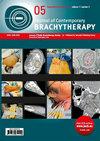Comparison of dosimetric analysis of organs at risk and target volumes for ovoids and cylinders in endometrial carcinoma
IF 1.1
4区 医学
Q4 ONCOLOGY
引用次数: 0
Abstract
Purpose:To compare dose volume parameters of target and organs at risk in vaginal vault brachytherapy using ovoids or cylinder in post-operative endometrial carcinoma.
Material and methods:
The study was done among 25 histologically proven post-operative endometrial carcinoma patients requiring vaginal brachytherapy. All patients underwent both cylinder and ovoids application alternatively on weekly basis. Ovoids size ranged from 2 to 3 cm diameter. Diameters of cylinder ranged between 2.5 and 3.5 cm. Bladder, rectum, urethra, and clinical target volume (CTV) were contoured on CT simulation images. Prescribed dose was 6-7 Gy in 2-3 fractions at 0.5 cm from the surface of applicator.
Results:
The mean values of D90, D50, V150, V100, V90, and V50 of CTV were comparable between cylinder and ovoids plans. The mean dose of CTV was significantly higher with cylinder than with ovoids, and D100 was significantly higher with ovoids (mean = 15.63 Gy vs. 14.64 Gy, p = 0.016, and D100 = 37.82% vs. 42.86%, p = 0.042, for cylinder vs. ovoids). In the dosimetry of the vault, D90, D50, V100, V90, V50, and mean of the vault did not show any significant difference between cylinder and ovoids. The V150 was significantly higher with cylinder plans than ovoids, and D100 of the vault was significantly higher with ovoids plans (V150 = 14.81% vs. 6.86%, p = 0.02, and D100 = 37.77% vs. 44.80%, p = 0.029, for cylinder vs. ovoids). D0.1cc, D1cc, D2cc, and mean for the bladder, rectum, and urethra were comparable between the cylinder and ovoid plans.
Conclusions:
The present study showed that the dose to organs at risk, most of the dosimetric parameters of CTV, and vault were comparable between the cylinder and ovoid plans. Both applicators provide good reproducibility. The choice of applicator will ultimately depend on the institutional policies and oncologist decision. However, in patients with dog-ear configuration of the vagina, ovoids may be preferred as per ABS guidelines.
子宫内膜癌中椭圆形和圆柱形风险器官和目标体积的剂量分析比较
目的:比较子宫内膜癌术后阴道穹隆近距离治疗中使用卵圆球或圆柱体时靶点和危险器官的剂量体积参数。材料和方法:研究对象是25名经组织学证实需要进行阴道近距离治疗的子宫内膜癌术后患者。所有患者每周交替使用圆柱形和卵圆球形放射剂。卵圆球的直径从 2 厘米到 3 厘米不等。圆柱的直径在 2.5 至 3.5 厘米之间。膀胱、直肠、尿道和临床靶体积(CTV)均在 CT 模拟图像上绘制了轮廓。结果:CTV的D90、D50、V150、V100、V90和V50的平均值在圆柱体和卵形体计划中相当。CTV的平均剂量圆柱形明显高于椭圆形,而椭圆形的D100明显高于圆柱形(圆柱形与椭圆形的平均值=15.63 Gy对14.64 Gy,P=0.016;D100=37.82%对42.86%,P=0.042)。在穹隆的剂量测定中,圆柱体和椭圆体的D90、D50、V100、V90、V50和穹隆平均值均无显著差异。圆柱形平面的 V150 明显高于椭圆形平面,而穹顶的 D100 则明显高于椭圆形平面(圆柱形平面与椭圆形平面的 V150 = 14.81% 对 6.86%,p = 0.02;D100 = 37.77% 对 44.80%,p = 0.029)。结论:本研究表明,圆柱形和卵圆形计划对危险器官的剂量、CTV 的大多数剂量学参数以及穹顶的剂量都相当。两种涂抹器都具有良好的再现性。涂抹器的选择最终取决于机构政策和肿瘤学家的决定。不过,对于阴道呈狗耳形的患者,根据美国放射治疗协会的指南,卵圆形可能是首选。
本文章由计算机程序翻译,如有差异,请以英文原文为准。
求助全文
约1分钟内获得全文
求助全文
来源期刊

Journal of Contemporary Brachytherapy
ONCOLOGY-RADIOLOGY, NUCLEAR MEDICINE & MEDICAL IMAGING
CiteScore
2.40
自引率
14.30%
发文量
54
审稿时长
16 weeks
期刊介绍:
The “Journal of Contemporary Brachytherapy” is an international and multidisciplinary journal that will publish papers of original research as well as reviews of articles. Main subjects of the journal include: clinical brachytherapy, combined modality treatment, advances in radiobiology, hyperthermia and tumour biology, as well as physical aspects relevant to brachytherapy, particularly in the field of imaging, dosimetry and radiation therapy planning. Original contributions will include experimental studies of combined modality treatment, tumor sensitization and normal tissue protection, molecular radiation biology, and clinical investigations of cancer treatment in brachytherapy. Another field of interest will be the educational part of the journal.
 求助内容:
求助内容: 应助结果提醒方式:
应助结果提醒方式:


